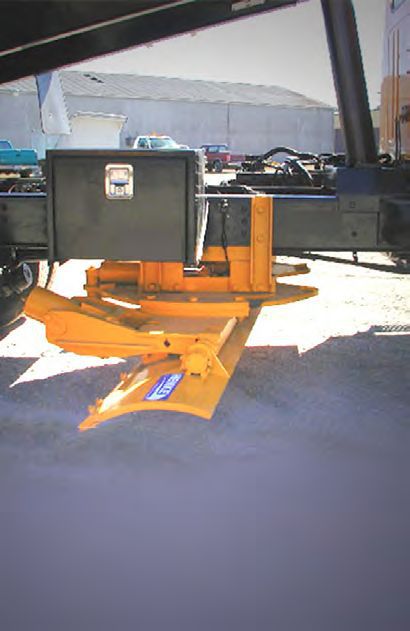MnDOT maintenance practitioners and managers are always looking for new and better ways to handle winter weather. A recent evaluation of new products revealed which of several new pieces of high-potential winter maintenance equipment were appropriate for use on Minnesota highways. Just as importantly, the agency uncovered the shortcomings of other equipment, identifying critical issues to address before acquiring additional equipment.
An active winter maintenance equipment industry frequently puts forward new equipment for agencies like MnDOT to consider. However, the promise of improved winter maintenance tools must hold up to the scrutiny of real-world experience. Will new equipment perform as advertised? Will it be straightforward to set up? Will it require frequent maintenance—both in the shop and in the field? Will it be worth the cost compared with traditional equipment designed to do the same task?
What Was Our Goal?
The goal of this project was to learn whether five pieces of new winter maintenance equipment would meet the real-world maintenance needs of different MnDOT districts. Of specific interest were three types of plow equipment produced by vendor Henke (an underbody scraper, a true-float wing plow and a two-way reversible plow) and two slurry spreader systems—one from vendor Swenson and one from Henke—designed to slide in and out of traditional box trucks and provide a multilane spread of salt-and-water slurry treatment.
What Did We Do?
Researchers undertook a multiwinter study with the cooperation of multiple MnDOT districts. Starting in north-central District 2, headquartered in Bemidji, the study tracked the delivery, installation and deployment of all five pieces of equipment. The first winter yielded limited hard data, but structured interviews with operators, shop maintenance staff, managers and the district superintendent revealed the promise and challenges of the equipment.
“New winter maintenance tools can lead to improved safety, lower costs and environmentally sound practices. Field staff in the districts applied creativity and know-how to find ways to make this equipment work,” said Tom Peters, maintenance research and training engineer, MnDOT Office of Maintenance.
A second winter of study in District 2 allowed for a full season of data collection. Of special interest was a comparison of each slurry spreader system with traditional spreaders on comparable routes. Investigators worked with MnDOT practitioners to develop a data collection and analysis plan to assess how the new spreaders compared. A key metric was whether the new spreaders could regain roads—or bring snow-covered roads back to bare lane condition—as quickly as traditional spreaders. Overall salt use was another metric. The study drew from existing MnDOT automated data collection processes and databases to extract the data required for the assessment.
Throughout and after both winter seasons, there were opportunities for field workers and managers to record and report specific challenges with all five pieces of equipment as well as remediation efforts. End-of-season interviews helped capture specific observations from MnDOT maintenance staff on how well the equipment performed and recommendations as to whether investing in more of the same was justified.

A third winter was planned for just the slurry spreaders in a different MnDOT district. However, several factors related to short staffing, equipment performance and part supply delays from a slurry spreader vendor led MnDOT to elect not to proceed with the third winter of study.
What Did We Learn?
Operation of the equipment over two winters provided for critical improvement steps. For example, the two-way reversible plow had performance issues in Winter 1, with snow buildup on the truck windshield making uninterrupted operation nearly impossible. However, additional experience in Winter 2 followed by operational changes—the use of a new type of plow blade and the addition of hardware to change the plowing angle—led to successful use of the equipment.
“Data-driven product evaluations like this one give MnDOT the experience and perspective needed to make smart capital investments,” said Brian Hirt, principal and CEO, CTC & Associates LLC.
The results on the slurry spreaders were less clear. From an operational standpoint, analysis of field data confirmed that the new equipment performed comparably to, but not necessarily better than, traditional slurry spreaders in terms of road regain time and salt use.
The slurry spreaders also had issues that were not resolved by the end of the study. These included excessive overall equipment height and weight caused by sliding one truck box into another. This led to difficulty loading salt into the spreader, limitations on how much salt could be loaded based on the truck’s maximum weight capacity, and some potential safety issues for operating and maintaining a tall and top-heavy vehicle.
Other challenges included difficulty in setup, equipment not operating as expected and difficulty obtaining parts and getting vendor support.
What’s Next?
MnDOT staff recommended the continued use and future acquisition of additional equipment for all three pieces of plowing equipment evaluated in this study. However, after a concerted multiyear effort to make the two slurry spreaders work, the participants did not reach consensus on whether to recommend their continued use. Possible alternative configurations, such as mounting the equipment on a boxless truck to lower the overall system height and weight, were put forward as a way to continue to think creatively about how to make this winter maintenance equipment work for MnDOT.

